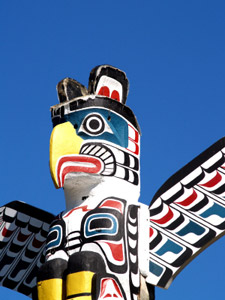Who were the first people inhabiting Canada?
Generally, the characteristics of Aboriginal cultures in Canada included ceremonial and civic architecture, permanent settlements, trading networks, and complex societal hierarchies. Genetic studies suggest that the first people inhabiting Canada (and the Americas) originated from a single ancestral population. When the glaciers began to melt, people were able to move east and south into Canada. The first settlers entered North America hunting Pleistocene mammals such as mastodons, musk ox, steppe wisent, woolly mammoths, and giant beavers.
The variety and vastness of fauna, vegetation, landform separations, and climates have defined ancient cultures. Language influences spiritual practices and social life and contributes to group identity. Animism and anthropomorphism have left a mark on aboriginal religions.
 Today, prehistoric cultures are also identified by nature and distribution of archaeological sites, subsistence practices, manufactured items, made of stone, and by rock art that gives an insight into their cultural beliefs.
Today, prehistoric cultures are also identified by nature and distribution of archaeological sites, subsistence practices, manufactured items, made of stone, and by rock art that gives an insight into their cultural beliefs. By 1000 BC, environmental and climatic conditions were similar to those encountered by European travellers. Cultural patterns were discernible, but innovation and diffusion were the major driving forces of cultural change. The introduction of pottery distinguishes Old Copper Complex societies from earlier cultures. The Woodland culture is a prehistoric culture that was characterized by raising squash, beans, and corns, the building of burial mounds, and the development of particular styles of pottery. During the 1st millennium AD, the Woodland culture, which had locales in the Maritime regions, Quebec, and Ontario, was replaced by the Mississippian culture. The oldest pottery excavated by archaeologists was manufactured by the Laurentian people. They belonged to a Montagnais First Nations tribe that inhabited the Laurentides until the French settled in the area in the 19th century.
Among the earliest people inhabiting the region were the Thule, the Dorset, the Dene, the Inuit, and the natives of Yukon. They were referred to as "Indians" by European explorers. These people had lived in the region for many years and had names for tribal or communal groupings. It is estimated that around 500,000 to 2,000,000 people resided in the region.
The northwest coast and Southern Ontario were more densely populated due to rich resources and farm land.
In the early 1600's Jaques Cartier came from France and this marked the starting of settlements in the country. Acadians who were French settlers were the very first Europeans to settle in the country. They were joined by the settlers from Germany and the British Isles. During the 1700's the British refugees from the war of independence who were loyalists came to this region and settled down here.